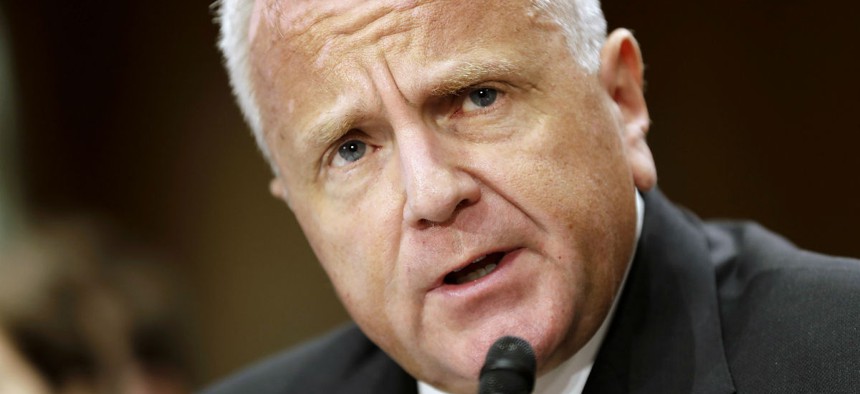
Deputy Secretary John Sullivan testifies before Congress. Jacquelyn Martin/AP
State Dept. Reform Plan Aims to Couple Drastic Cuts With Making Employees’ Lives Easier
Department spells out five tenets of redesign; Democrats skeptical of intentions.
The State Department insisted on Tuesday it is not aiming to shrink the influence of its workforce or the role of U.S. diplomacy in the world, saying during a congressional hearing the cost cutting it achieves through its redesign would instead free its employees from burdensome bureaucratic hurdles.
State has built a bottom-up model for its reorganization, Deputy Secretary John Sullivan told the House Foreign Affairs Committee, noting 72 percent of the members of the redesign team were “working-level employees.” Secretary Rex Tillerson wanted career employees to “drive this process from beginning to end,” Sullivan said, so the department and the U.S. Agency for International Development could better serve them.
“Their presence and contribution proved to be invaluable,” Sullivan said.
In planning the reorganization required of every agency by an executive order from President Trump and subsequent guidance from the Office of Management and Budget, State has so far come up with five major tenets:
- Streamlining the process for creating policy to realign State’s physical footprint and more quickly turn field input into recommendations and action;
- Maximizing the impact of foreign assistance;
- Increasing efficiency, reducing costs and redundancies and improving services for personnel around the world to help employees change posts and improve their skills sets;
- Optimizing human resources support; and,
- Improving information technology platforms and modernizing legacy systems.
Democrats on the panel repeatedly blasted the Trump administration for what they said was working backwards in its approach to its redesign, namely coming up with a massive 32 percent budget cut and then finding efficiencies and reforms to match that figure. Members of the minority party expressed skepticism when Sullivan said the department would have undertaken a similar reorganization review whether it faced budget cuts or increases, and that the spending and reform plans should be evaluated separately.
“This reorganization effort,” said Rep. Brad Sherman, D-Calif., “I hope is not a cover for or a reason to delay filling posts.”
“Many of us are concerned this is simply a downgrading of our diplomacy by a different name,” said Rep. Ted Deutch, D-Fla., while Rep. David Cicilline, D-R.I., called State’s approach a “perversion of the process.” Rep. Eliot Engel, D-N.Y., the committee’s ranking member, said he hopes that “when the administration talks about efficiency that it’s not just a code for budget cuts.”
Rep. Gerry Connolly, D-Va., cast doubt on the proposed budget cuts being a “bottom-up recommendation.”
Connolly said if he were an employee making recommendations for reform, but he was facing “attrition or layoffs of somewhere near 2,000 employees, I’d say that puts a little damper on my effort to reorganize the State Department because I’d be worried about my own job.” Trump’s fiscal 2018 budget proposal called for slashing State’s workforce by 1,400 employees, or 4 percent.
Sullivan said State’s redesign will start immediately, but will “continue throughout our tenure in office.” Some of the proposed reforms will require legislation from Congress, he added, while some will happen internally. Many of those reforms will focus on improving the lives of its employees, he explained.
“When we talk about efficiency and effectiveness, part of it is the budget and the cost savings, but part of it is also empowering our men and women in the foreign service and the civil service [to free them from] redundant bureaucratic processes or bureaucratic processes that don’t serve our people well,” Sullivan said.
Part of that effort, he explained, will involve helping the families of its diplomats overseas. He noted the department has made 800-900 exceptions to its ongoing hiring freeze to find civilian jobs for the spouses of its foreign service officers. He also vowed to boost the diversity of State’s workforce, including by recruiting and interviewing for the foreign service on military bases.
The deputy secretary admitted the department faces a morale crisis, citing uncertainty from the reorganization and a failure by the public to praise the foreign and civil service as it does the military.
Rep. Gregory Meeks, D-N.Y., in part blamed State’s lack of communication for those issues.
“They still don’t know what the final plan is, the information flow hasn’t gotten down,” Meeks said. “They don’t know whether what they’ve recommended will be heard.” The congressman also expressed concern that there is a trend of fewer employees around to “promote our diplomacy."
Engel said career officials are starting to “flock to the exits,” and Tillerson is “uninterested in the input and expertise of our most seasoned professionals.”
Sullivan said he and State leadership are “doing our best” to improve morale at the department.
“We’re doing all we can now to ensure them this process is employee-led, they are valued and diplomacy is valued by the government and this secretary,” Sullivan said.
“Good to hear,” Connolly quipped in response. “I hope they believe it.”
CORRECTION: A previous version of this story had an erroneous reference to anticipated cuts to the State Department's HR workforce.
NEXT STORY: Another Misleading Claim About Federal Pay







